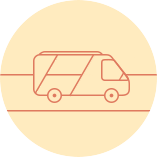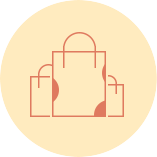Online store of the future: from predictions to reality

Recently, I was sorting out old drafts and came across a small article titled “Online Store of 2050”. In it, I talked about how the perfect
')
Search and selection of goods
Forecast
The online store of the future is not a store in the usual sense of the word for us now. This is the function that surrounds a person literally everywhere. For example, you come to ski, and you see on the slope of a steep skier. Hover the augmented reality display device on it, turn on the “Things” mode, and right here and now with callouts you can see what equipment it is wearing, how much it costs and where it is sold.
Reality
Amazon Flow: Turning Items into Goods in Real Time
Forecast

Here you can "go back" to the virtual showcase, look at the vending thing from all angles (first 3D and holography, with the development of technology - a tactile model), see how it sits on you taking into account your individual anatomical features.
Reality
Products in 3D:
Virtual showcase:
.
Forecast
The profile is stored in your mobile device, entered once and can be used in all sites or applications, just as the current location is now used: “The store wants to use your individual dimensions. Allow? Virtual fitting immediately highlights potentially problematic places - short sleeves, narrow shoes, etc. Ideally, with the development of technology, light fitting of clothes should be done automatically, or by simple fitting in the workshop just before the sale.
Reality
Custom tailoring and tailoring, storage of profiles: http://www.getwear.com , http://constrvct.com/
Purchase and delivery

Forecast
The procedure for the purchase and delivery should also be simplified at times. One-click purchase, as in the AppStore, delivery to one of the predefined personal POIs (home, office, country house) or to one of the points of the Unified Network of Delivery Points, which will replace regular stores. In the first case, you need to specify only a convenient delivery time, and in the second - the nearest point of delivery, which, in most cases, will be determined automatically.
Reality
Trekking Development and Globalization www.dhl.com

Forecast
Trigger to turn on the showcase can be anything: a video on the Internet, advertising in the subway or in the media, people on the street. At any place, at any time, the showcase is available for viewing using a portable mobile device equipped with an augmented reality device (glasses, holographic projector, something else).
Reality
Internet showcase in the Moscow metro
An important service of the stores of the future, as well as modern ones, will be the comparison option: you can immediately see their analogues and key differences from the thing that initially attracted the user's attention, right at the place of purchase, to see reviews not only of ordinary buyers, but also of "authorized" ones experts. Commodity experts who will study the products of certain groups, test them and prepare reviews for global online storefronts will become respected and famous people.
Possible applications of augmented reality:
Address advertising and work with preferences

All “aggressive” advertising should be personalized, targeted and context-sensitive. This principle should be preserved not only on the Internet, it will apply to any channels of communication. Advertising will depend on the location, time of day, clothing and mood of a particular person. Vouchers to the country club will be offered to you when you are tired and you have time and the opportunity to relax, and not with the letter from the “We need to work on the weekends” manual.

Stores must analyze user behavior and process any requests coming into the information environment, including implicitly. For example, if you write in Fb “advise which bike is better?”, You do not need the contextual ad “Are you looking for a bike? We have them! ” You want to solve your unique problem. Talk to a specialist - with a live person or an expert system - understand and clarify your own preferences, choose not from the assortment of a particular store, but from the whole variety of models available, compare prices with and without delivery, and decide whether you are ready to wait a month, or tomorrow you want to go to the park. In particular, you should be offered as an alternative hire for one or two days or a season. Of course, with this approach, some industries, for example, manufacturers of SLR cameras, will be seriously affected. But this is a topic for a separate conversation.
Retailers

Large retailers, in one way or another, will have to unite into a single network, and the competition will only work at the level of “service packages”, discount programs and bonuses, just as it is now with mobile operators. That is, a person has an account tied to a specific retailer, and, for example, all sports goods (and in the long run - all products in general) are acquired through this retailer. In such cases, brands will be chosen, not stores (as is already partly happening now), and it will only be possible to compete at the customer service level, since the range of goods and prices will be about the same.
Shopping areas will degenerate into small boutiques, where particularly violent shopaholics will be able to physically look at and touch goods, take part in tests and installations, but all retail space will go online, and the goods ordered in the boutique will be delivered home or in delivery point. Each stage of the order is monitored in real time, each operation (the goods are shipped from the warehouse, the courier has left, etc.) a short message comes
I will sum up. The essence of the proposed upgrades at the methodology level can be put into the following theses:
- obtaining information about the surrounding objects as goods, effortlessly - “at your fingertips”;
- constantly open access to the global showcase of goods;
- complete, consistent and multifaceted information about each product;
- tracking personal conditions and preferences, offering products in the right place at the right time;
- offering alternative ways to solve the problem without acquiring a particular product: for example, rental of equipment or equipment, or a team of builders instead of a screwdriver;
- the shortest and least expensive way at all stages of the “saw-bought” procedure;
- quality feedback.
How do you see the online store of the future?
PS: Special thanks to Sasha Lovyagin for illustrations to the article.
Source: https://habr.com/ru/post/192656/
All Articles